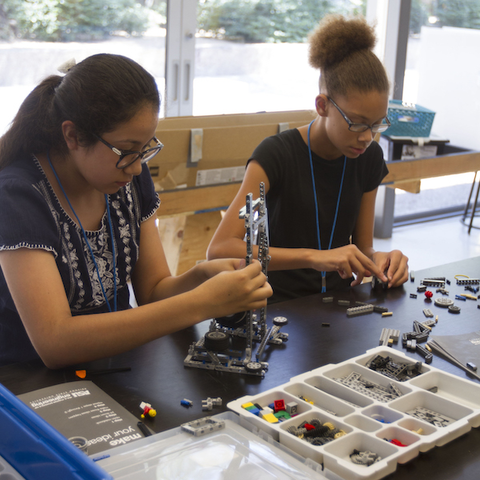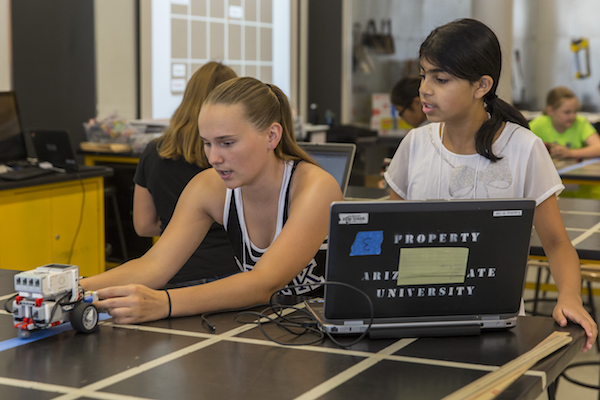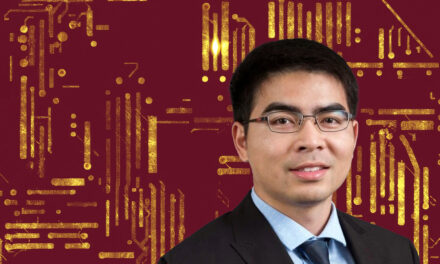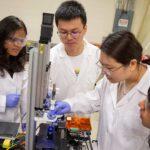
Overcoming invisibility: Helping students envision their futures as engineers

Above: Tirupalavanam Ganesh (second from left) has developed educational outreach programs designed to encourage young students “to explore things that help them envision the future they could create for themselves as engineers.” Photographer: Jessica Hochreiter/ASU
New programs aim to remove barriers to career possibilities
Engineering has a bit of an invisibility problem, says Arizona State University education researcher Tirupalavanam Ganesh.
It’s an obstacle that presents a particularly acute challenge for efforts to spark interest in the field among youngsters.
“Engineers do things that impact a lot of everyday life, but you don’t see engineers portrayed in movies, video games or on TV and the other things that are shaping youngsters’ views of the world,” says Ganesh, an associate research professor and the assistant dean of engineering education in ASU’s Ira A. Fulton Schools of Engineering.
“They know entertainment celebrities, and they know sports stars. But they don’t know the engineers who created the microchip that makes their computers work,” he adds. “It’s not on their radar.”
A result is that many bright and motivated young students — and their parents — aren’t including engineering on the list of potential careers when they start giving serious thought to their futures.
Ganesh’s mission is to change that, especially for those within groups whose young adults have not pursued higher education or careers in the field in significant numbers — a largely untapped talent pool, he says.
He recently began accelerating his drive toward that goal with the help of resources being provided by way of a Tooker Professorship he was awarded earlier this year.
Driving toward diversity in engineering
The professorship was established five years ago with an endowment from Diane and Gary Tooker. Diane Tooker is a former elementary school teacher. Gary Tooker is a former chief executive officer of the Motorola technology company and an ASU engineering alumnus.
The Tooker Professorship supports work to attract students to engineering and provide them innovative learning environments and educational experiences that keep them engaged, and equip them with a competitive edge in the job market.
This fall semester, Ganesh — with help from the Fulton Schools’ student recruitment and retention specialists — is forming a group of about 120 students from six high schools in the greater Phoenix metropolitan area for a program he is calling Young Engineers Shape the World.
Aimed at attracting students who are enrolled in Advanced Placement or International Baccalaureate courses in high school, and who are pursuing advanced science and mathematics courses, this program seeks to increase the representation of women in engineering.
“A more diverse engineering workforce will help increase the variety of innovations that can make a difference in people’s lives,” Ganesh says.
The high school juniors will gather for 90 minutes each week for 15 to 17 weeks during the academic year to engage in a series of activities to introduce them to the possibilities of an engineering career.
Students will get opportunities to interact with university engineering students and see research projects that ASU engineering majors are conducting.
These high school students and their families will get tours of ASU from the Fulton Ambassadors, the student volunteer group that helps promote the Fulton Schools.

The programs Young Engineers Shape the World and Engineering Futures aim to show teens and young adults the relevance of engineering in everyday life and to provide them a network of mentors, peers and role models. Photographer: Jessica Hochreiter/ASU
Keeping aspiring engineers on track to careers
“The idea is to show them rather than just tell them about the kind of impact engineering has on society,” Ganesh says, “and most importantly, to encourage them to explore things that help them to envision the future they could create for themselves as engineers.”
The key to doing that is to remove that cloak of invisibility that makes engineering all but invisible to many young students.
“Engineers help make possible the technology we use every day. The roads we drive on, the medical technology that improves our quality of life, and the energy, security, housing, healthcare and entertainment we have access to all involve engineering. Once students see engineering in that light, they realize all the variety it offers for what they could do with their lives,” Ganesh says.
The cohort will stay together for two years until they graduate from high school and enter college. They will also experience a week-long summer program at the ASU campus exploring what campus life is like.
A second project, called Engineering Futures, which he is getting off the ground with Tooker endowment support, focuses on ASU freshman engineering majors — in particular students who are in the first generation in their families to go to college and/or those with financial need.
The goal is to boost the persistence of young engineering students who may not be familiar with a university environment and may not know what engineers actually do in the workplace.
“They are the students who most often will not have a support structure of peers and role models who are engineers around them,” Ganesh explains. “We want to provide them a network that will give them those things, and help keep them on track with their education and career pursuits.”
Building pathways to future success
The plan is for Engineering Futures groups to stay together from the start of the students’ freshman year until the end of their sophomore year.
During that time they will participate in short courses and workshops designed to instruct them how to effectively build teams to collaborate on academic studies as well as extracurricular projects in which they apply engineering skills.
They will learn to use software and other technologies to help them organize projects and to develop methods, systems, tools and products from the design stage to actual production.
They’ll be introduced to the basics of research, entrepreneurship, professional leadership and communications, with a concentration on skills that are most useful in the workplace.
Along the way, students will get a chance to connect with more experienced engineering students, alumni and professional engineers.
“The industry partners we are recruiting to work with the Engineering Futures program are excited and eager to get involved,” says Robin Hammond, director of the Fulton Schools Career Center. “They understand that these Tooker-sponsored programs are essential to building pathways for the exceptional engineers and talented future employees that their companies have come to expect from ASU’s Fulton Schools of Engineering.”

Ganesh’s outreach programs stress that effective education doesn’t result from students competing against each other for higher grades, but learning skills by working together to achieve goals. Photographer: Jessica Hochreiter/ASU
Support network key to sustaining motivation
In the first of these pilot programs, Ganesh explains, “We are showing high school students how to imagine what their future could be like if they chose to study engineering.”
In the second program, “We are showing freshmen and sophomore students how they can begin to construct that future for themselves while they are here at the university, and how that is a collaborative project you do with your teachers, mentors, industry professionals, advisors and fellow students.”
He says education research has shown what is essential to the success of such endeavors: sustained effort, group support and instilling a sense of greater purpose.
“It takes a support network, a community that shares problems and challenges and aspirations,” Ganesh says. Succeeding is not a matter of competing against others to get higher grades, but of working together to learn skills and accomplish goals that benefit the group.
And it takes time for individuals to evolve into such a communal venture.
“Short-term orientation just does not work,” Ganesh says. “To build the self-confidence you need to succeed, you have to explore and experience things over a long period of time.”
Seeing engineering as a ‘helping profession’
Beyond that, getting students to major in engineering and persist in the face of difficulty requires showing them they are not training to be simply competent technicians who are going to be doing skilled but unfulfilling jobs.
“They need to feel that their work can make a difference,” Ganesh says. “There is solid evidence that this is a critical motivation for students, to know they will learn things that can improve their communities and society.”
One of the impediments to turning teens and young adults toward engineering is that “it is not always seen as the helping profession that it is,” he says.
“We are living in a world with seven billion people that is going to be in greater need of all the basic things necessary to live well, and engineers are going to have roles to play in providing all of those things,” he says. “We have to make young people aware of the relevance that engineering will always have.”
Media Contact
Joe Kullman, [email protected]
480-965-8122
Ira A. Fulton Schools of Engineering



































